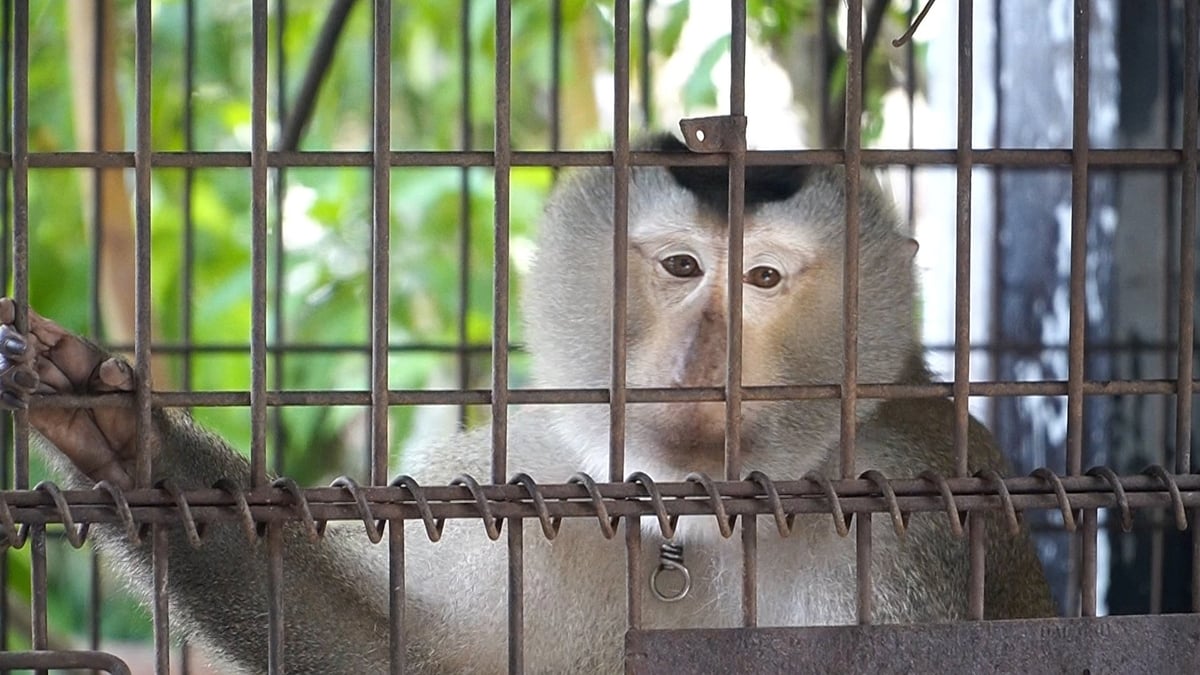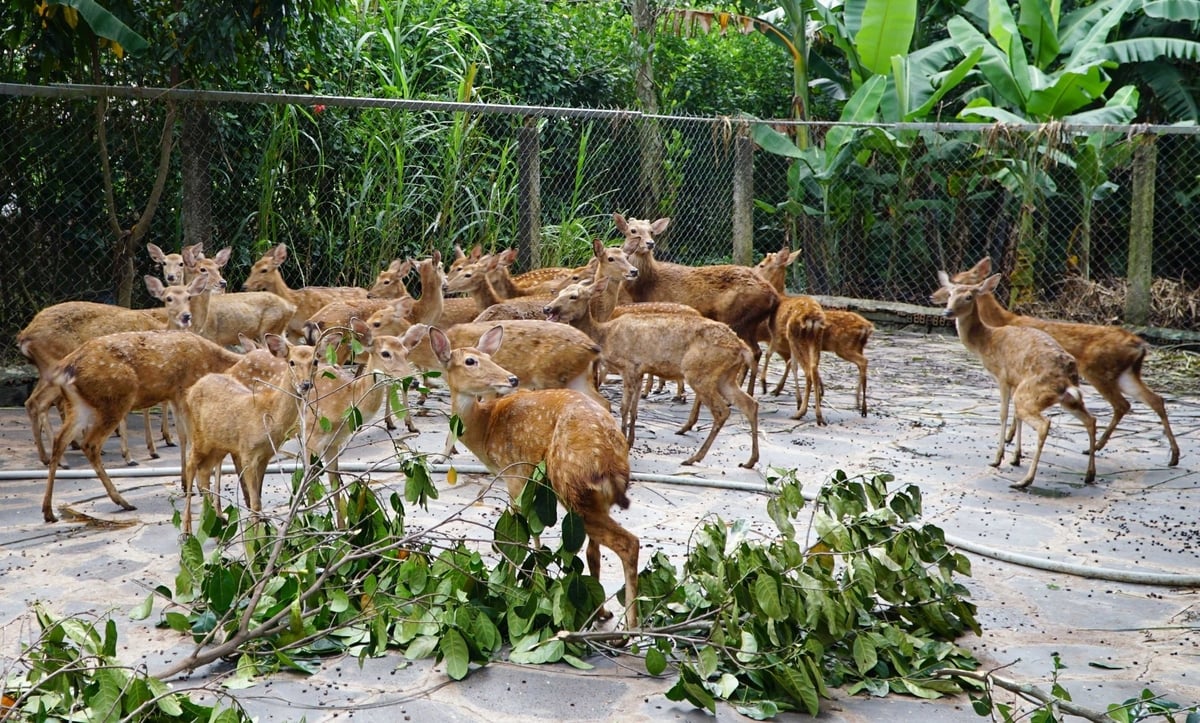November 25, 2025 | 01:16 GMT +7
November 25, 2025 | 01:16 GMT +7
Hotline: 0913.378.918
November 25, 2025 | 01:16 GMT +7
Hotline: 0913.378.918
From August to September 16, 2024, the My Quynh Zoo (formerly Long An province) reported the deaths of 30 tigers and lions. Concurrently, in Dong Nai province, 20 tigers and one leopard at the Vuon Xoai Tourist Area also succumbed to unusual deaths.

Veterinary staff of Dong Nai province took animal feces samples for testing after 21 tigers and 1 leopard died from A/H5N1 flu. Photo: Le Binh.
Laboratory test results confirmed that samples taken from the tigers at the zoo were positive for Avian Influenza A/H5N1. Consequently, at that time, a total of 51 tigers, leopards, and lions died from the highly virulent A/H5N1 avian influenza virus.
Despite close epidemiological monitoring, proactive surveillance measures, vaccinations, and biosecurity protocols by veterinarians at these facilities, the progression of the disease was remarkably swift. Mr. Nguyen Truong Giang, Head of the Dong Nai Sub-Department of Livestock Production and Animal Health, admitted: "The incident unfolded too quickly and was unbelievable, especially since disease control efforts had been quite robust. Nevertheless, the Sub-Department immediately implemented isolation, containment, and strict monitoring to prevent further spread”.
Currently, nationwide, there are nearly 12,000 wildlife farming facilities housing over 2.5 million individual animals from 300 species. However, household and individual operations account for 90% of these facilities. Alarmingly, the knowledge of disease prevention among these farmers is extremely rudimentary.
"Captive wildlife is still considered a 'blind spot' for the veterinary sector", commented Associate Professor Dr. Le Thanh Hien, Head of the Department of Infectious Diseases and Community Veterinary Medicine, Faculty of Animal Science and Veterinary Medicine, Ho Chi Minh City University of Agriculture and Forestry. "Monitoring, disease prevention, and outbreak reporting are not mandatory for wildlife as they are for livestock and poultry. This represents a significant loophole from a public health perspective”.
The confusion surrounding the handling of tiger and leopard deaths in Dong Nai and Long An (old provinces) highlights a lack of clear professional guidelines for preventing and controlling infectious diseases in captive wild animals. Furthermore, current vaccines are primarily designed for traditional livestock, with very few suitable formulations for species like tigers, bears, or monkeys.
Associate Professor Dr. Le Quang Thong, Head of the Faculty of Animal Science and Veterinary Medicine, Ho Chi Minh City University of Agriculture and Forestry, also conceded, "We do not fully understand wild animals as we do traditional livestock. Many pathologies in wild animals are quite new, requiring us to exchange experiences with international colleagues. For many cases, we can only treat symptoms based on experience. There's a lack of testing equipment, suitable medications, and certainly no vaccines”.
Moreover, a lack of coordination among stakeholders further complicates the issue. Forest Rangers are responsible for origin and conservation, veterinarians handle livestock diseases, and the human health sector has not been sufficiently proactive regarding the risk of disease transmission from wild animals to humans. Farmers often lack specialized knowledge, training, and adequate funding. Meanwhile, diseases do not respect administrative boundaries.

The risk of disease transmission from wild animals to humans is assessed as increasingly fragile and many immune gaps are exposed. Photo: Le Binh.
Experts have repeatedly warned that if wild animals continue to remain outside the surveillance system, Vietnam will face unpredictable new disease risks, threatening not only animals but also humans.
According to the 2023 report by the World Organization for Animal Health (WOAH), over 70% of new emerging infectious diseases in humans originate from animals, primarily from wild species. Influenza A, SARS, MERS, Henipavirus, and Corona have all been recorded in species such as bats, migratory birds, pangolins, and rodents.
In Vietnam, a collaborative study between Oxford University and the Pasteur Institute in Ho Chi Minh City, published in 2022, revealed a high detection rate of bat-related and rodent-related coronaviruses in samples from certain wild animal collection and captive breeding sites in the South.
"We have only managed to monitor diseases in livestock and poultry, while surveillance for wild animals, both in forests and in captive facilities, remains insufficient," stated Associate Professor Dr. Le Thanh Hien. "Once a virus appears in captive breeding facilities, just one loose link can allow the disease to spread to livestock, and from there, reach humans”.
Another notable point is that many wild animal breeding facilities are located near residential areas or livestock farms. Avian Influenza A/H5N1 can transmit from wild birds to carnivorous mammals, as seen in the Dong Nai case. Without a coordinated warning mechanism among veterinary services, forest rangers, human health agencies, and local authorities, the risk of new outbreaks is entirely plausible.

Captive wild animals remain vulnerable to many disease risks due to lack of proper attention. Photo: Le Binh.
Within the region, several countries, such as Thailand and Indonesia, have implemented integrated disease surveillance models for wild animals into their public health systems. In Vietnam, although the "One Health" strategy has been discussed for years, most activities currently focus on human health and industrial livestock farming. Wild animals remain the weakest link in the chain of combating transboundary diseases.
The H5N1 avian flu tiger deaths are not an isolated incident. Since 2024, the H5N1 virus has spread widely among wild animal populations, including penguins, migratory birds, and captive cattle in the United States. This indicates a growing global trend.
However, in Vietnam, it specifically highlights a system with many gaps, lacking connectivity and investment in wildlife health. Amidst climate change, urbanization, and increasing consumer demand, wild species are living closer to humans than ever before. Neglecting their health directly jeopardizes our own safety.
"To prevent epidemics at their root, we must monitor where viruses are likely to emerge. In most cases, that's wild animals. The alarm bell has rung; the question is whether we will hear it and act in time", warned Associate Professor Dr. Le Quang Thong, Head of the Faculty of Animal Science and Veterinary Medicine, Ho Chi Minh City University of Agriculture and Forestry.
Translated by Linh Linh

(VAN) Viet Nam is entering the pivotal period of 2025-2030, moving toward the formulation of the Remote Sensing Law, which will establish a legal foundation for the development of national digital data.

(VAN) The agricultural sector is finalizing the strategic framework for emission reduction, setting the goal of sharply cutting methane and 403.7 million tons of CO2 equivalent and moving toward Net Zero by 2050.
/2025/11/22/2236-1-153832_483.jpg)
(VAN) The National Marine Spatial Planning is opening up opportunities for sustainable blue sea development across 21 coastal localities.

(VAN) Viet Nam’s forestry sector is undergoing a comprehensive transformation, strengthening management, protection, and development efforts to maintain ecological security and drive green, sustainable growth.

(VAN) Viet Nam is accelerating efforts to digitize reservoir operations, from real-time data to hydraulic modelling.
/2025/11/21/3348-2-102623_454.jpg)
(VAN) National Assembly delegate Nguyen Thi Lan has proposed adding special mechanisms to attract human resources to the agricultural, forestry, and fishery sectors, addressing the shortage of high-quality personnel.

(VAN) Over the past two decades, the unified legal framework for water resource management has been perfected, becoming a crucial foundation for ensuring national water security.